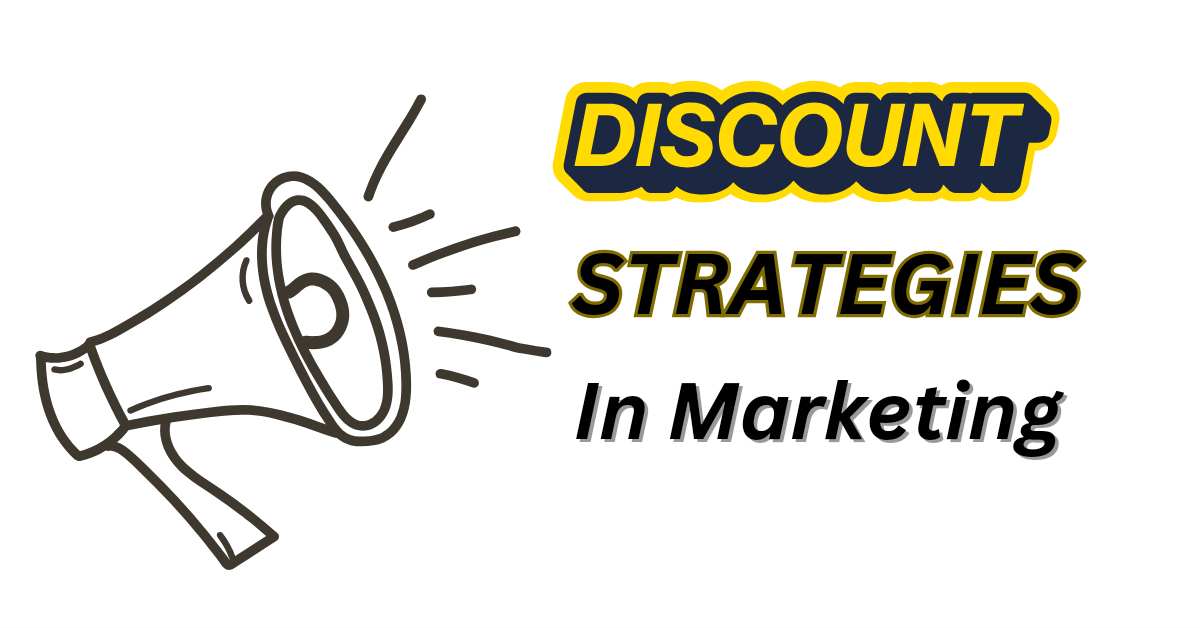Summary of discount strategy in marketing
• Discounts and schemes are used to attract customers to your products.
• Loyalty member discount involves giving extra benefits to customers who are loyal to your product.
• Try before you buy involves giving products to customers for trial before asking for money.
• Promotional discounts or seasonal discounts are given during holidays/ big events for clearing out inventory.
• Volume discount is given when someone buys your product in bulk.
• First time shopper schemes are given for acquiring new customers while early bird discounts are given for promoting new product.
• Flash sales is rolling out big discounts during events/festivals for a limited period of time.
• Discount for special groups involves giving discounts to a certain and fixed group like army officials, blinds, etc.
• Store credit or subscription credit is given on store rather than on products.
• Discounts on social media involve giving alluring coupons/discounts on the purchase of a product.
• Bundled discount is bundling products and reducing the total price of purchase rather than reducing the selling price of one product.
What are the types of discounts
How can you bring growth in your sales by giving good discounts and schemes?
Top 10 Discount schemes for customers :
• Loyalty member discount
• Try before you buy
• Promotional discount
• Volume discount
• Early bird discount
• Flash sales
• Discount for special groups
• Store credit or subscription credit
• Discounts on social media
• Bundled discount
Let us discuss these strategies in detail.
1: Loyalty Member Discount
You can give numbers of loyalty program discount. You can:
• Add members to your loyalty programmes
• Give discount on next purchase
How to make guards of loyalty framework/membership? There are agencies for this. Search for them on Google.
If you have a factory or retail service, then you can implement loyalty system. It’s not difficult, it’s very easy.
Golden statement:
If people believe they share values with a company, they stay loyal with that company.
Based on customer’s buying habits:
• Upsell products
• They might purchase expensive products
• Introduce exclusive membership
• Give exclusive perks and experiences to top advocates
Top advocates are those who praise you more and bring new customers every day.
For example:
If you have a gym and a customer is bringing more customers to the gym, then you can give him a personal training, personal training credit, special health drinks, mass gainer, weight loss products for free of cost or at discount.
2: Try Before You Buy
This promotion is becoming very popular in e-commerce. This works as a freemium.
In try before you buy, a businessman sends a sample product to customer for trial because in e-commerce there is a barrier as you can’t touch, see, or try the product. In showrooms, customers can try clothes on and that is why e-commerce had to take this step.
You can also check how to use this model for your business. In this, the customer basically has to pay the shipping price; they receive the product at their home and can try it. They get a time period of one week, two weeks or a month and then the amount gets deducted from their linked credit card.
3: Seasonal or Promotional Discount
You can give seasonal discounts to your customers to clear out old inventory.
For example:
Generally, seasonal discounts are given on winter clothes when summers is about to arrive and on summer clothes when winters are about to arrive.
You can mark down the price of some out of season products to sell them quickly.
Promotional discounts examples are given:
• Limited time discount
• Toward the end of product life cycle
• During holidays/big events
• Buy One Get One Free (BOGO)
Buy One Get One Free has become popular in promotional discounts. In Buy One Get One Free, on buying one product, you can either give another product free of cost or at discounted price.
4: Volume Discount
You can give a volume discount when someone purchases in bulk. It is very effective in Business-To-Business (B2B).
For example:
If you sell office supplies, you can tell your customers that those who will purchase 20 cartons of 500 papers will get a huge discount.
Apart from volume discounts, there are multi-buys. In multi-buys, you can roll out offers like buy 10 for the price of 5 which makes people purchase multiple items. You should plan and have a strategy for bulk.
5: First Time Shopper/Early Bird Discount
The terms first time shopper and early bird discount are two different things.
First time shopper schemes are basically to:
• Acquire new customers: When you are not getting customers, then you should give a discount or scheme to the first shoppers and promote it outside your shop/store. This will help in attracting new customers.
• Incentivise customer to buy at least one product: You incentivise the customer for the first time. After that, if your product is good, then the customer will buy it again even without discount.
The second term is early bird discount. This refers to the discount given for promoting a new product. When you launch a new product, you can give early bird discount to some customers.
For example:
• Many online stores offer pre-order discounts that benefit them.
6: Flash Sales – Event Based Discount
A perfect example for this is Big Bazaar that offers flash sales like ‘the cheapest 5 days’.
E-commerce companies like Amazon and Flipkart roll out annual flash sales twice or thrice a year for a limited period. Like around Independence Day or Republic Day of India, these companies give a lot of flash sales discounts or event based discounts. Here, they focus on volume.
The Xiaomi – Flipkart flash sales story was very famous. Xiaomi has done several flash sales.
Big Bazaar roll out offers in the market during festivals and their profit status is reported in the media.
You should take care of three things while doing flash sales i.e. your sales should be:
• Time-bound i.e. it should not be for a longer period
• Limited quantity i.e. the quantity should finish before time
• Significant discount
This kind of model is called Fear Of Missing Out (FOMO) in which the customers purchase the product quickly due to the fear of missing the opportunity.
This helps to clear out your old inventory and stabilise existing inventory.
Before going for a flash sale, keep these points in mind:
• Customer-oriented products
• Promote sale ahead of time
• Word it correctly
• Find the sweet spot (i.e. use exact scheme and don’t be like Tata Nano that neither goes as bike nor as car)
• Create limited time offer
• Create good advertisement to attract customers
• Use countdown timer (like 2 days left, 3 days left, 1 day left, 6 hours left, 1 hour left, etc.)
• Host flash sales events (this will bring a boost in sales suddenly)
• Incorporate last chance sections (like you are opening the sales again last time for 2 hours)
• Check inventory (Lack of inventory will be a problem for you; so, keep inventory with you)
7: Discount for Special Group
In this strategy, you can focus on your consumer group, those whom you can give discount for the whole year.
Normally, this can be done as a CSR activity, like you can give continuous discounts to:
• Army officials
• Blinds
• Divorcee women
• Pregnant mothers
• Widow mothers
• Specially abled people
• Students
It is a special type of discount and maintains your brand value. You give discount to some customers, but you can showcase it in a bigger manner. This way, you don’t give away big discounts, but you help certain people.
8: Store Credit or Subscription Credit
This type of discount is for a store. Instead of giving discount on a product, you give the discount to customers when they come back to your store.
For example:
• You can choose not to give discount on products of your store but can give 5% discount whenever a customer comes back to your store.
Store credit can be used only in your store, so, the customer has to come back to the same store.
Customers feel good because they can save some money. This increases the chances of customers coming back to the store, improves customer repurchase rate, and creates brand recall in customer’s mind.
9: Best Discount Strategy on Social Media
This type of discount is very popular these days. You can:
• Promote offers on social media
• Hold contests
• Conduct polls
• Ask questions & encourage users to interact
• Encourage users to follow your brand
• Free shipping is popular in e-commerce business
• Free home delivery can be done by local shops or stores
Coupon programmes are also very famous on social media these days.
Examples of such coupons for buying your products are:
• Free Pizza Hut coupons
• Cash coupon – Phone Pay & Google Pay (because you have done partnership with them)
• 50% off on first five meals on Zomato/Swiggy (This can be done by partnership with Zomato/Swiggy. Many companies do such partnerships and also benefited from them as you can save your cash outflow. If it is 50% discount, then you need not to give 50% cash because you have done their promotion; so, you will get the benefit as well.)
• 80% off on medicine
• Free sample products like L’Oréal free sample
These types of discounts save cash outflow but give good discounts to the customers.
10: Bundled Discounts
Rather than lowering down the selling price of your product, you can bundle total products by reducing the total price, which makes your product sell in bulk.
In this, you can take the full price of one important product and can give other products complimentary or you can accumulate all the products and reduce their total price.
There are many ways of bundling.
For example:
• A computer hardware supplier bundles up by giving installation support free with a purchase.
• A hairdresser bundles up by shampooing or drying your hair for free after a haircut.
We hope you liked these 10 strategies but before giving a discount, make sure you’re not spending from your own pocket and customer is also leaving you after first purchase and not coming back to you.
Conclusion:
• Implement the discount strategies as per your products or business
• Use discounts or schemes to acquire new customers, clear out the old inventory, and boost your sales
• Give coupons to your customers on a purchase for saving your cost.

